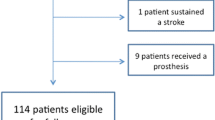Abstract
Introduction
The primary aim of this study was to determine the effectiveness and safety of an intraarticular triamcinolone injection for the treatment of stiffness after the operative treatment of proximal humerus fractures.
Materials and methods
88 patients who underwent plate fixation for proximal humerus fractures were enrolled. The patients were randomly divided into two groups, with Group I receiving a glenohumeral injection of triamcinolone 8 weeks postoperatively and Group II receiving no injection postoperatively. Outcomes were measured and compared based on the range of motion (ROM) and functional scores. Follow-up outcomes were assessed at initial, 3, 6 and 12 months postoperatively and at the last follow-up. Shoulder trauma series were taken at every visit to evaluate the fracture healing. The mean follow-up period was 25.37 (± 3.85) months Group I and 24.24 (± 6.23) months for group II.
Results
In both groups, the final outcome of the ROM and functional outcome was significantly better at last F/U than at postoperative 8 weeks. Group I had significantly better results than Group II at postoperative 3 and 6 month in terms of forward flexion, external rotation, and VAS for pain. Also, Group I showed better performance in terms of ASES and Constant score at postoperative 3 months. The fracture union rate did not differ between Groups I and II.
Conclusions
Postoperative glenohumeral injection of triamcinolone is a safe and effective treatment modality for shoulder stiffness after internal fixation of proximal humerus fractures during the early period of rehabilitation.



Similar content being viewed by others
References
Aspenberg P, Sandberg O (2013) Distal radial fractures heal by direct woven bone formation. Acta Orthop 84(3):297–300
Calvo E, Morcillo D, Foruria AM et al (2011) Nondisplaced proximal humeral fractures: high incidence among outpatient-treated osteoporotic fractures and severe impact on upper extremity function and patient subjective health perception. J Shoulder Elbow Surg 20(5):795–801
Chen WT, da Han C, Zhang PX et al (2015) A special healing pattern in stable metaphyseal fractures. Acta Orthop 86(2):238–242
Corrales LA, Morshed S, Bhandari M, Miclau T 3rd (2008) Variability in the assessment of fracture-healing in orthopaedic trauma studies. J Bone Joint Surg Am 90(9):1862–1868
Gupta AK, Harris JD, Erickson BJ et al (2015) Surgical management of complex proximal humerus fractures-a systematic review of 92 studies including 4500 patients. J Orthop Trauma 29(1):54–59
Hanson B, Neidenbach P, de Boer P, Stengel D (2009) Functional outcomes after nonoperative management of fractures of the proximal humerus. J Shoulder Elbow Surg 18(4):612–621
Hardy R, Cooper MS (2011) Glucocorticoid-induced osteoporosis disorder of mesenchymal stromal cells? Front Endocrinol (Lausanne) 2:24
Kim KH, Park JW, Kim SJ (2018) High- vs low-dose corticosteroid injection in the treatment of adhesive capsulitis with severe pain: a randomized controlled double-blind study. Pain Med 19(4):735–741
Kim YS, Lee HJ, Lee DH, Choi KY (2017) Comparison of high- and low-dose intra-articular triamcinolone acetonide injection for treatment of primary shoulder stiffness: a prospective randomized trial. J Shoulder Elbow Surg 26(2):209–215
Kumagai K, Vasanji A, Drazba JA, Butler RS, Muschler GF (2008) Circulating cells with osteogenic potential are physiologically mobilized into the fracture healing site in the parabiotic mice model. J Orthop Res 26(2):165–175
Platzer P, Kutscha-Lissberg F, Lehr S, Vecsei V, Gaebler C (2005) The influence of displacement on shoulder function in patients with minimally displaced fractures of the greater tuberosity. Injury 36(10):1185–1189
Richards R, An K, Bigliani L et al (1994) A standardized method for the assessment of shoulder function. J Shoulder Elbow Surg 3(6):347–352
Roh YH, Yi SR, Noh JH et al (2012) Intra-articular corticosteroid injection in diabetic patients with adhesive capsulitis: a randomized controlled trial. Knee Surg Sports Traumatol Arthrosc 20(10):1947–1952
Sandberg OH, Aspenberg P (2015) Glucocorticoids inhibit shaft fracture healing but not metaphyseal bone regeneration under stable mechanical conditions. Bone Joint Res 4(10):170–175
Tejwani NC, Liporace F, Walsh M, France MA, Zuckerman JD, Egol KA (2008) Functional outcome following one-part proximal humeral fractures: a prospective study. J Shoulder Elbow Surg 17(2):216–219
Thelen MD, Dauber JA, Stoneman PD (2008) The clinical efficacy of kinesio tape for shoulder pain: a randomized, double-blinded, clinical trial. J Orthop Sports Phys Ther 38(7):389–395
Yoon JP, Oh JH, Min WK, Kim JW, Jeong WJ, Lee HJ (2012) What do the patients want and worry in Korean patients who undergo arthroscopic rotator cuff surgery? Clin Orthop Surg 4(4):278–283
Funding
No external funding was received for this investigation.
Author information
Authors and Affiliations
Corresponding author
Ethics declarations
Conflict of interest
The authors declare that they have no conflict of interest. There is no financial remuneration for any authors or any members of their family.
Ethical approval
This article contains studies with human participants performed by the authors. IRB approval was given by IRB of Seoul St. Mary’s Hospital, the Catholic University of Korea, Study no.: KC17OESI0118.
Informed consent
Informed consent was obtained from all individual participants included in the study.
Additional information
Publisher's Note
Springer Nature remains neutral with regard to jurisdictional claims in published maps and institutional affiliations.
Rights and permissions
About this article
Cite this article
Kim, YS., Lee, KG. & Lee, HJ. Effect of triamcinolone acetonide on stiffness after surgical treatment of proximal humerus fractures: a randomized controlled study. Arch Orthop Trauma Surg 140, 1731–1737 (2020). https://doi.org/10.1007/s00402-020-03425-3
Received:
Published:
Issue Date:
DOI: https://doi.org/10.1007/s00402-020-03425-3




